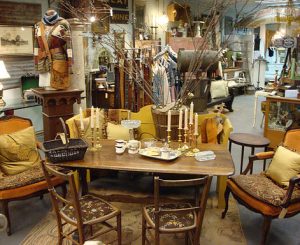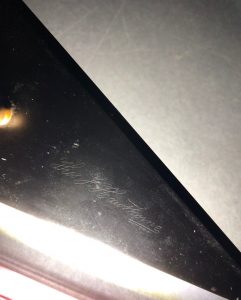C is for Connoising, or, my inability to rest during spring break
My fellow first-years and I are in the throes of spring semester – keeping up with weekly assignments, working on connoisseurship block projects, and outlining our summer research plans. That said, it is easy to forget how much we have learned in a relatively short period of time. To illustrate this point, I want to explain how my spring break included an unintentional exercise in connoisseurship.
The final weekend of spring break, I scoured Napa’s local antiques shops in search of a Montgomery Prize object. Yes, waiting until the last minute to find an object was a risky move, but I was certain I would find something worthwhile out West. Exploring The Annex, I did a double take when I noticed a pointy object encased next to mourning jewelry. Months of practiced close looking kicked in as I requested access to the object. Our Metals Connoisseurship block had not started, but my mind immediately began processing my observations.
Okay, a metal triangle. Draftsman’s tool? I’ve never seen a metal one, so maybe not. Looks late 19th/early 20th century to me. It’s in pretty good condition. A little rust on the narrow-most underside, but nothing too severe. Is this a brass knob? Why is there a knob? Maybe it helps steady your grip while you trace. What kind of triangle is this? I wish I had a protractor…Oh, a name! “Thos F. Hawthorne. London.” Is this the maker, owner, or a brand? Was Thomas in London? What is this object doing in Napa?! The script looks early 20th century but London’s script looks really different. This is just odd. Where’s my phone?

Consequences of impulse purchases: TSA considered this object “too pointy and sharp” to put into my carry-on luggage.
Unable to find immediate answers, I decided that the only rational solution was to buy the triangle. Did I have a need for it? Absolutely not. Was I going to conduct an investigation in my spare time? Obviously, yes.
Reflecting on this impromptu connoisseurship experience (and a rare instance of impulse shopping), I am surprised by how immediate and natural it was to “connoise” an unfamiliar object. Within an academic year, I have apparently strengthened my ability to examine, analyze, and brainstorm through studying an object’s materiality. My observations have led to thoughtful questions (and research rabbit holes) that I would not have explored if not for my connoisseurship training. Allowing an object’s materiality to guide research allows me to think both critically and creatively about how to best contextualize an object. So, thanks, WPAMC!

Searching through price lists and trade catalogs, I discovered this page taken from William Marples & Sons Ltd.’s 1909 price list. It advertises other drafting tools, cases and set squares. However helpful, drawings can be deceiving. No. 7242 is actually a wooden set square with a hole in the center. You can imagine my disappointment when I realized the hole was not a knob.
Just in case you were wondering, the object I bought is indeed a drafting tool. Technically called a set square, the contemporary term, ‘triangle,’ is also used. Steel or hard rubber set squares did exist, but wood and celluloid squares were most commonly produced. Interestingly, the trade catalogs that advertise set squares only feature squares with openings, which highlights the uniqueness of my knobbed set square. Additionally, set squares were typically purchased in pairs (generally 30/60 and 45/45) so draftsmen could create lines of 15-degree increments. It is likely that my metal set square is missing its partner, which was nowhere to be found in The Annex. These initial findings are hopefully just the beginning! I do not enjoy unsolved mysteries, so I will continue my search (and close looking) to learn more about my new object.
By Elizabeth Humphrey, WPAMC Class of 2019



Leave a Reply